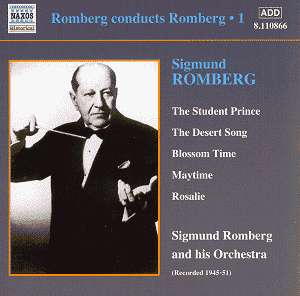This is one of two Romberg discs of the same Naxos
series, taken from recordings made between 1945-51. The Victor Record
Company had decided they would like a definitive set of recordings by
the composer while still alive, so between the ages of 67 and 71 he
went back into the recording studio. The material was originally released
on 78 and LPs in five volumes as 'Gems from Romberg Operettas'
along with an instrumental album 'Waltzing with Romberg'. The
Student Prince ballet was first issued as a 45 and later transferred
to an LP entitled 'Dinner Music'
Sigmund Romberg was born in Hungary but where
Kálmán held on to certain Bohemian characteristics Romberg
left these behind when he started to compose for the stage. Whilst studying
in Vienna he gained insight into theatre technique from an association
with the Theatre an der Wien. After visiting the United States as an
engineer in 1909 he returned to New York in 1913 where he turned to
music and composed songs for a revue. He lost no time in writing his
first operetta, The Midnight Girl (1914) and went on to compose
scores for the Passing Show of 1914 (and others), working with
Al Jolson on Sinbad (1918). Then in 1924 Friml's popular Rose
Marie was eclipsed by Romberg's The Student Prince,
which had been adapted from an earlier score, Old Heidelberg
of 1903. The Student Prince took off, making Romberg a Broadway
name. The musical was soon exported back to Britain and Europe in its
new form.
The Student Prince opened very successfully
on Broadway in 1924 with lyrics by Dorothy Donnelly who also wrote Blossom
Time three years earlier. Stirring rhythms, enticing romance
and an easy plot were its hallmarks of appeal. Set in Heidelberg, Germany,
the show originally began with the title, Old Heidelberg which
was changed after its try-out. In this version both the Students'
Chorus and Golden Days are spoilt by an inappropriate dreamy
'Barber's Shop' style of presentation.
The Desert Song, written two years
after Student Prince, with libretto by Hammerstein II, Harbach
and Mandel, was launched with a good cast, much good music, colour and
romance. It was destined to match the popularity of The Student Prince.
Within six months it was also playing in London at Drury Lane. The operetta
is set in North Africa in the 1920s against a background of discontent
between the French colonials and local guerrillas, "The Riffs". A 'Valentino'
style love story takes place between the French commander's daughter,
Margot, and the Riff leader, Red Shadow (whose face nobody has seen).
The score with its brilliant tunes and rhythms reflect the confidence
now gained by Romberg from the success of The Student Prince.
Numbers like One Alone and Romance were
destined to become showstoppers.
Victor and Romberg assembled a good cast for these
recordings, and the composer enjoyed a very responsive orchestra. It
appears that he may have altered some of the early orchestration. Where
these recordings score over the early transcriptions by Pearl is that
we are able clearly to hear the detail in Romberg's orchestration. The
singing is strong throughout. Gone is the 'flutter vibrato' and affected
diction so fashionable in pre-war recordings and the electric xylophone
which became tiresome in the London Victor recordings of the late 1920s.
Naxos might have offered more extensive notes as the
ones provided give no detail about the stage circumstances surrounding
individual numbers. Since one can hear echoes of Schubert in Blossom
Time (an interesting pastiche by Romberg) it would have been welcome
to have been told about the Schubertian content of this and the Lilac
Time operettas. Purchasers today are not likely to know their content.
However, they do provide a good account of Romberg's life, though sketchy
in relation to his early background and influences. Details of the record
matrices are given.
Raymond Walker
